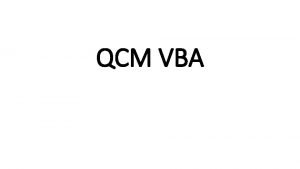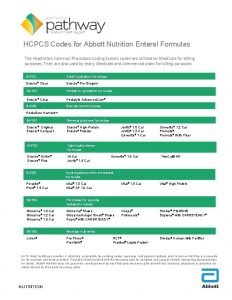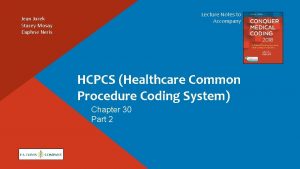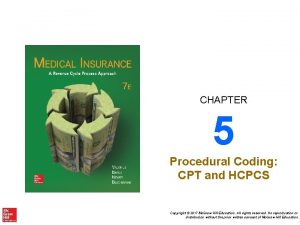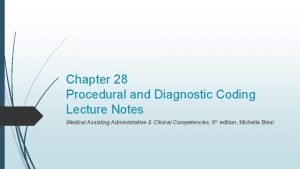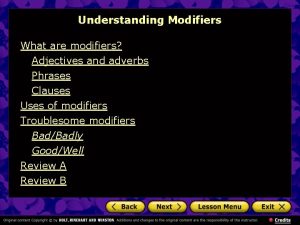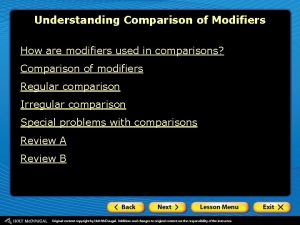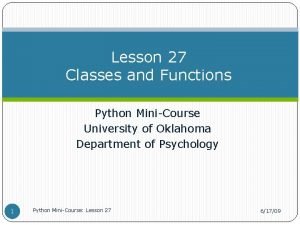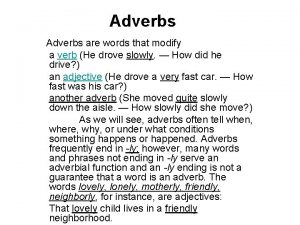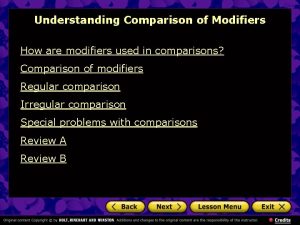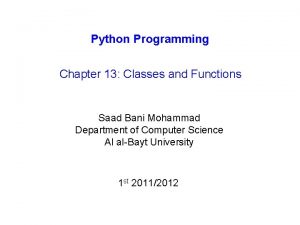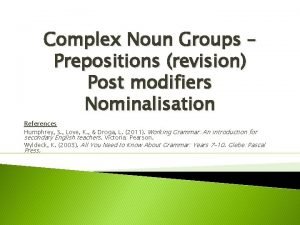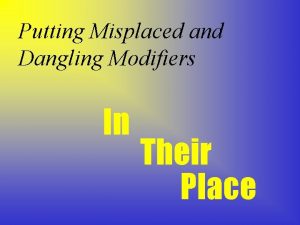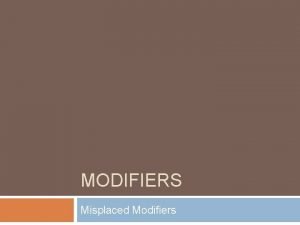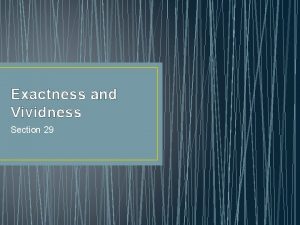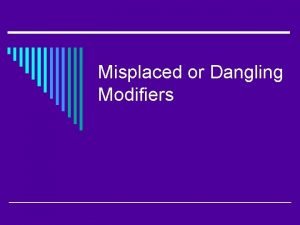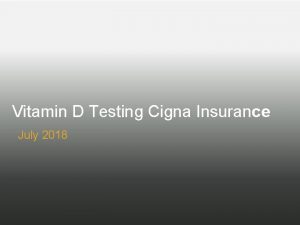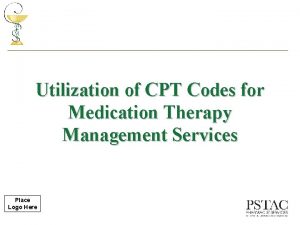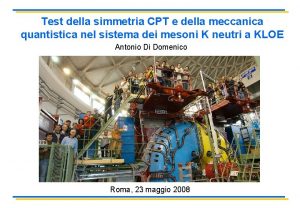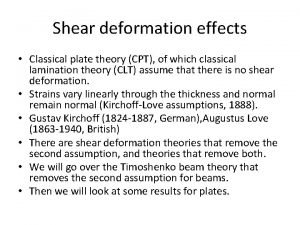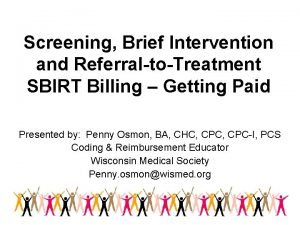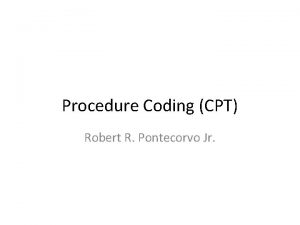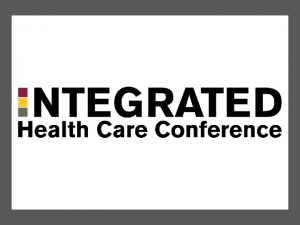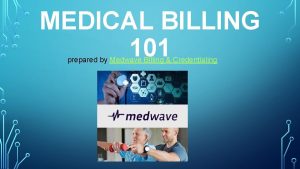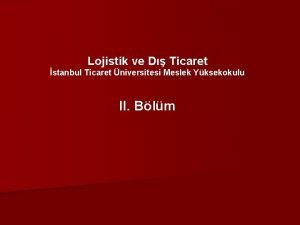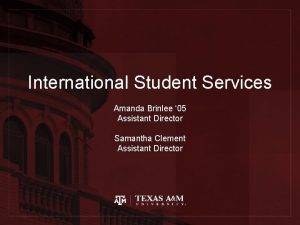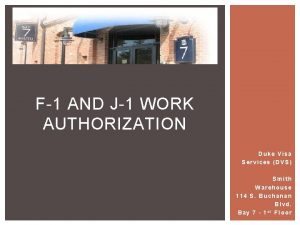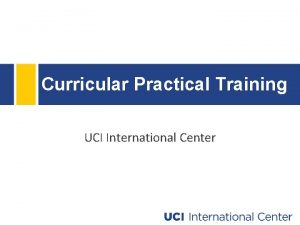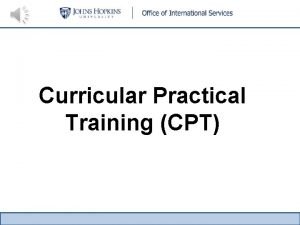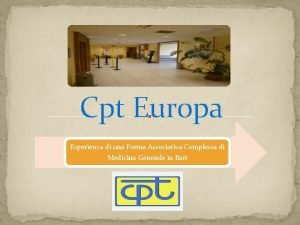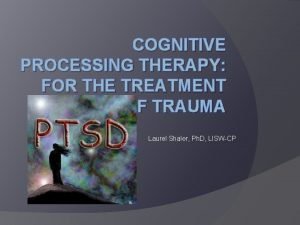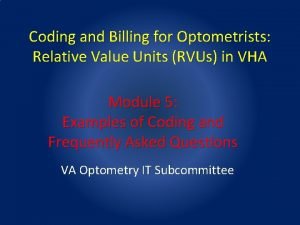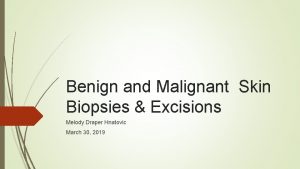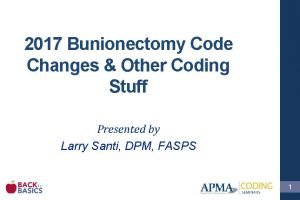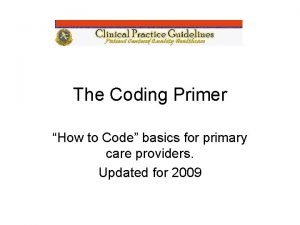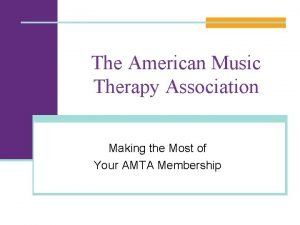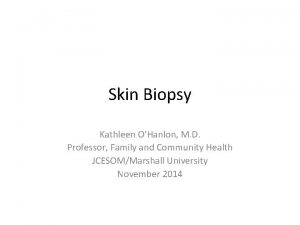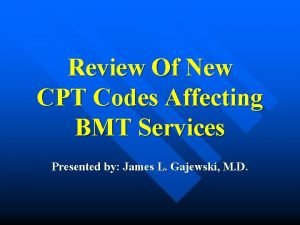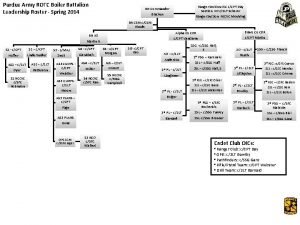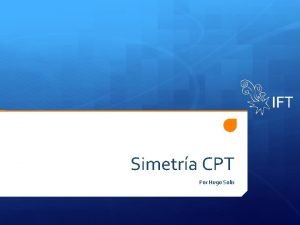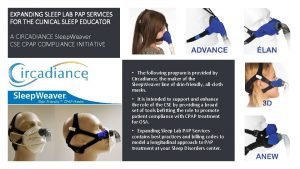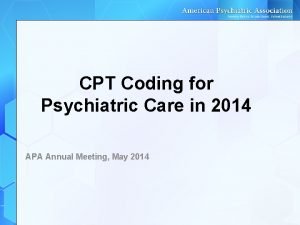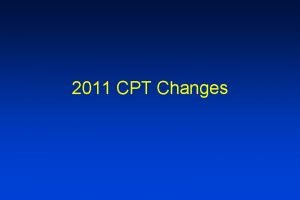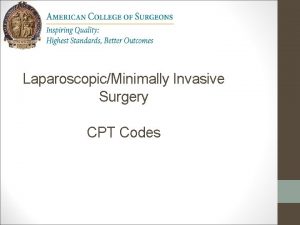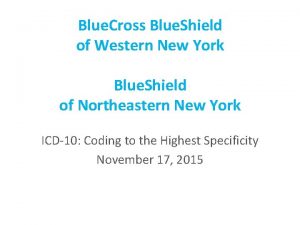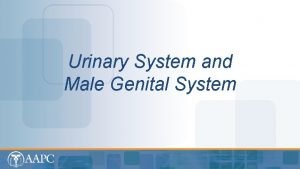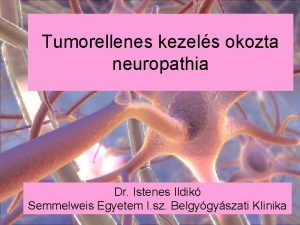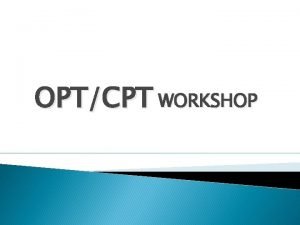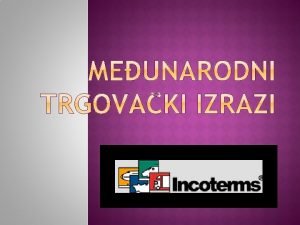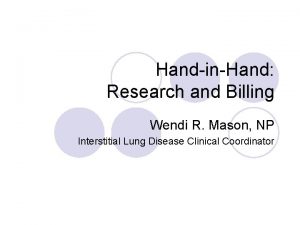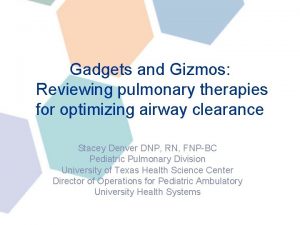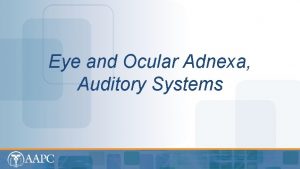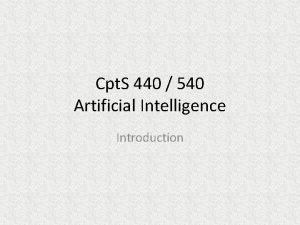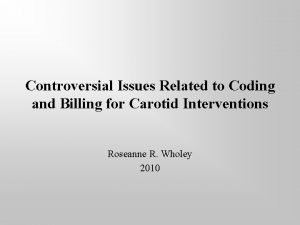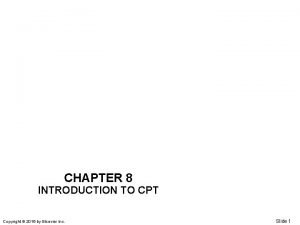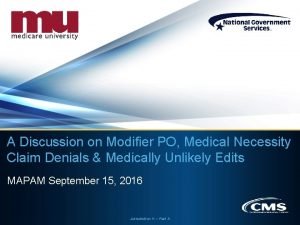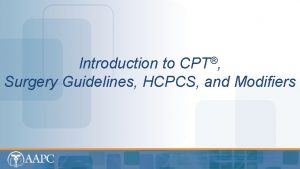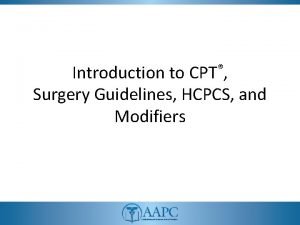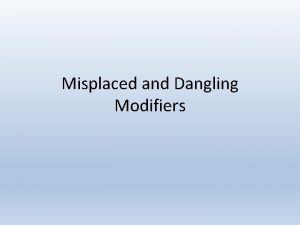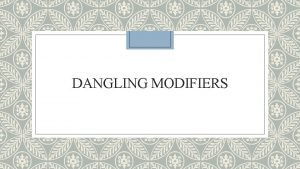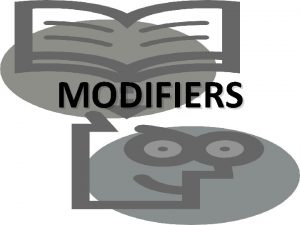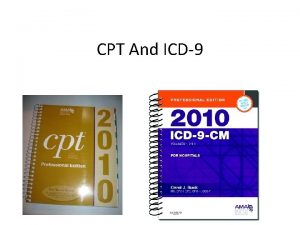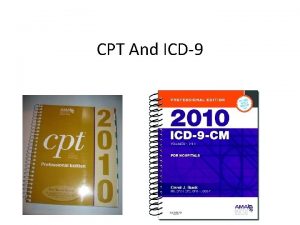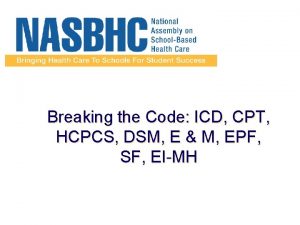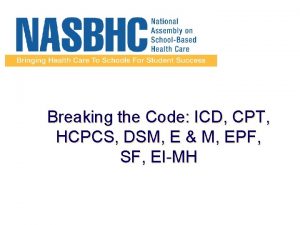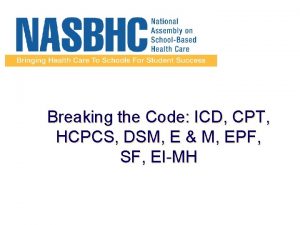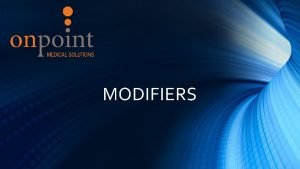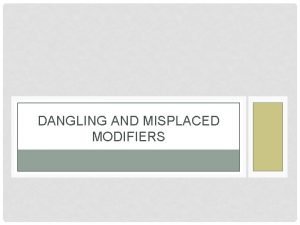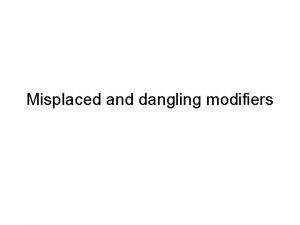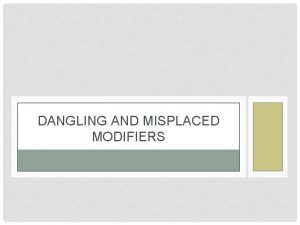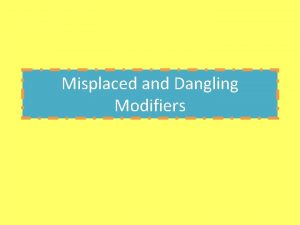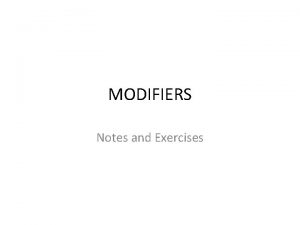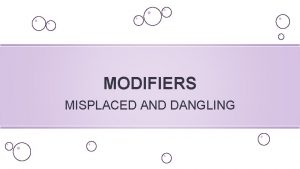Introduction to CPT Surgery Guidelines HCPCS and Modifiers














































































- Slides: 78

Introduction to CPT®, Surgery Guidelines, HCPCS, and Modifiers Chapter 06

The Current Procedural Terminology (CPT®) • Copyrighted and maintained by American Medical Association (AMA) • Used with other codes sets to report healthcare services performed in the United States • Established as an indexing/coding system to standardize terminology among physicians and other providers

Introduction to CPT® • Instructions for use of the CPT ® code book – Unlisted procedure – CPT ® use by any qualified health care professional – Parenthetical notes – Accuracy and quality of coding • Related guidelines • Parenthetical instructions • Other coding resources

Introduction to CPT® • The CPT® code set includes three categories of medical nomenclature with descriptors. – Category III

Category I CPT® Codes • Five-digit numerical code, eg 12345 • Over 7, 000 service codes, plus titles and modifiers • Reviewed and updated annually • Mandatory to report for services and reimbursement

Category I CPT® Codes The CPT® coding manual divides Category I CPT® codes into six main section titles: – Evaluation and Management (99201– 99499) – Anesthesiology (00100 -01999) – Surgery (10021 -69990) – Radiology (70010 -79999) – Pathology and Laboratory (80047 -89398) – Medicine (90281 -99607)

Category I CPT® Codes • Section titles have subsections divided by anatomic location, procedure, condition, or descriptor subheadings. • The subheadings, structured by CPT® conventions, may list alternate coding suggestions in parenthetical instructions. • Example: • • Alternate coding suggestions Section: Surgery (10021 -69990) Subsection: Integumentary System Subheading: Skin, Subcutaneous and Accessory Structures Category: Debridement » » (For dermabrasions, see 15780 – 15783) (For nail debridement, see 11720 -11721) (For burn(s), see 16000 -16035) (For pressure ulcers, see 15920 -15999)

Category I CPT® Codes Specific guidelines presented at the beginning of each section identify correct coding protocols. Example: Section, Surgery Subsection: Cardiovascular System (33010 -37799) Guideline: Selective vascular catheterizations should be coded to include introduction and all lesser order selective catheterizations used in the approach (e. g. , the description for a selective right middle cerebral artery catheterization includes the introduction and placement catheterization of the right common and internal carotid arteries).

Category II CPT® Codes • Alphanumeric format, with the letter “F” in the last position, eg, 0001 F • Optional “performance measurement” tracking codes • Physician Quality Reporting Initiative (PQRI) • Example: – A physician counsels a patient regarding prescribed Statin therapy for coronary artery disease. – Report: • 4002 F Statin therapy, prescribed (CAD) • Appropriate level office visit code (99211– 99215).

Category II CPT® Codes Due to the constant expansion of identifiable measures for quality patient care, the AMA lists criteria on their website: http: //www. ama-assn. org/ama/pub/physicianresources/solutions-managing-yourpractice/coding-billing-insurance/cpt/aboutcpt/category-ii-codes. shtml Physician Quality Reporting Initiative (PQRI) http: //www. cms. gov/PQRI/

Category III CPT® codes • Temporary codes • Alphanumeric structure, with a “T” in the last position, eg, 0019 T • Can be reported alone, without an additional Category I code • Example – A patient has gastric stimulation electrodes implanted in the lesser curvature of the stomach via laparotomy for the treatment of morbid obesity. – Report code 0157 T Laparotomy, implantation or replacement of gastric stimulation electrodes, lesser curvature (eg, morbid obesity).

Category III CPT® codes • Updated twice a year – January 1 – July 1 • Implemented six months after • Updates are published on AMA’s website: http: //www. ama-assn. org/go/CPT

The CPT® Coding Manual • • CPT® Sections Section Guidelines Section Table of Contents Notes Category II codes (0001 F – 7025 F) Category III codes (0019 T – 0259 T) Appendices A-N Alphabetic Index

CPT® Guidelines • Referenced in the introduction of each section and subsection of the CPT® manual • Applicable to the section being referenced • Define the information necessary for choosing the correct code

CPT® Conventions and Iconography Used throughout the CPT® manual and include: – Indentations – Code symbols - iconology – Parenthetical instructions

CPT® Conventions and Iconography Example: Indentation 11000 Debridement of extensive eczematous or infected skin; up to 10% of body surface. Iconography + (Symbol) 11001 Parenthetical Instruction each additional 10% of the body surface (List separately in addition to code for primary procedure) (Use 11001 in conjunction with 11000)

CPT® Conventions and Iconography ; The semicolon and the conventional use of indentions The use of the semicolon divides the description of a code into two parts: • The “stand-alone” code or the “common procedure” code descriptor. • The indented descriptor is dependent on the preceding “stand-alone” code

CPT® Conventions and Iconography Example: 00160 00162 00164 Anesthesia for procedures on nose and accessory sinuses; not otherwise specified radical surgery biopsy, soft tissue Interpreted: 00160 00162 00164 Anesthesia for procedures on nose and accessory sinuses; not otherwise specified. Anesthesia for procedures on nose and accessory sinuses; radical surgery Anesthesia for procedures on nose and accessory sinuses; biopsy, soft tissue

CPT® Conventions and Iconography + The “add-on” code symbol - Add-on codes are never reported alone Example: +43283 Laparoscopy, surgical, esophageal lengthening procedure (eg, Collis gastroplasty or wedge gastroplasty) (List separately in addition to code for primary procedure) (Use 43283 in conjunction with 43280, 43281, 43282)

CPT® Conventions and Iconography l The red circle - new procedure code Example: l 33620 Application of right and left pulmonary artery bands (eg, hybrid approach stage 1) p The (blue) triangle - code revision Example: p 47480 Cholecystotomy or cholecystostomy, open, with exploration, drainage, or removal of calculus (separate procedure)

CPT® Conventions and Iconography ut The facing triangles - indicate new and revised text other than the procedure descriptors • Example: Endoscopy u. When performing an endoscopy on a patient who is scheduled and prepared for a total colonoscopy, if the physician is unable to advance the colonoscope beyond the splenic flexure, due to unforeseen circumstances, report the colonoscopy code with modifier 53 and appropriate documentation. t 46020 Placement of Seton u (Do not report 46020 in addition to 46060, 46280, 46600, 0249 T) t

CPT® Conventions and Iconography W The circle with a line through it - exempt from the use of modifier 51 Example: W 93612 Intraventricular pacing

CPT® Conventions and Iconography 8 The bulls eye - includes moderate sedation Example: 8 43200 Esophagoscopy, rigid or flexible; diagnostic, with or without collection of specimen(s) by brushing or washing (separate procedure)

CPT® Conventions and Iconography The lightening bolt symbol - codes for vaccines that are pending FDA approval. Example: 90661 Influenza virus vaccine, derived from cell cultures, subunit, preservative and antibiotic free, for intramuscular use AMA CPT® “Category I Vaccine Codes” website: www. ama-assn. org

CPT® Conventions and Iconography # The number symbol - Resequenced and are out of numerical order Example: 46947 # 46947 Code is out of numerical sequence. See 46700 -46947. Hemorrhoidopexy (for prolapsing internal hemorrhoids) by stapling

CPT® Code Basics • • Review medical documentation thoroughly and gather additional reports Reference the alphabetical index for a CPT® numerical code and/or code range. – – • • Condition Procedure or service Anatomic site Synonyms, eponyms and abbreviations Review the numerical code and/or code range for specific descriptions Follow CPT® Guidelines, Conventions and Iconology

CPT® Code Basics • Index: – Ear Wax see Cerumen – Cerumen Removal………………. . 69210 – Removal Cerumen………………. 69210 • Auditory System 69210 Removal impacted cerumen (separate procedure), one or both ears

Separate Procedure Example: 69210 Removal impacted cerumen (separate procedure), one or both ears 69222 Debridement, mastoidectomy cavity, complex (eg, with anesthesia or more than routine cleaning).

National Correct Coding Initiative (CCI) • Implemented by CMS • Promotes correct coding methodologies • Controls the improper assignment of codes that results in inappropriate reimbursement Medicare publishes CCI: http: //www. cms. hhs. gov/National. Correct. Cod. Init. Ed/


Sequencing • Based on RBRVS – Physician Work – Practice Expense – Professional Liability/Malpractice Insurance • Highest RBRVS listed first. www. cms. hhs. gov/Physician. Fee-Sched/

CPT® Assistant • • • Articles answering everyday coding questions CCI bundling information E/M billing guidance Current code use and interpretation Case studies demonstrating practical application of codes • Anatomical illustration charts and graphs for quick reference • Information for appealing insurance denials • Information to validate code usage when audited

CPT® Appendices Appendix A - Modifiers categorized as: – Modifiers applicable to CPT® codes – Anesthesia Physical Status Modifiers – CPT® Level I Modifiers approved for Ambulatory Surgery Center (ASC) Hospital Outpatient Use – Level II (HCPCS/National) Modifiers

CPT® Appendices • Appendix B - changes and additions to the CPT® codes from the previous year • Appendix C - clinical E/M examples for different specialties • Appendix D – Add-on Codes

CPT® Appendices • Appendix E – Exempt from the use of modifier 51 (multiple procedures) • Appendix F – Exempt from the use of Modifier 63 (procedures performed on infants less than 4 kg) • Appendix G – Include Moderate (Conscious) Sedation

CPT® Appendices • Appendix H – Alphabetic Index of Performance Measures by Clinical Condition or Topic – Available only on the AMA website – www. ama-assn. org. • Appendix I – Genetic Testing Code Modifiers – Molecular laboratory procedures related to genetic testing – Use in conjunction with CPT® and HCPCS codes to provide diagnostic granularity of service

CPT® Appendices • Appendix J - Electrodiagnostic Medicine Listing of Sensory, Motor, and Mixed Nerves – Assigns each sensory, motor, and mixed nerve with its appropriate nerve conduction study code – Table containing maximum number of studies • Appendix K - Product Pending FDA Approval – Identified throughout the CPT® book with a lightening bolt symbol – For updated vaccine approvals by the FDA, visit the AMA CPT® Category I Vaccine Code information on their website: www. ama-assn. org/ama/pub/category/10902. html

CPT® Appendices • Appendix L - Vascular Families – Based on the assumption that a vascular catheterization has a starting point of the aorta – Illustrates vascular “families” that emerge from the aorta using brackets to identify the order of vessels. • Appendix M - Crosswalk to Deleted CPT® Codes – Crosswalks noting the deleted CPT® codes and descriptors from the previous year to the current year. – Essential when updating charge masters, charge capture documents, etc.

CPT® Appendices Appendix N - Summary of Resequenced CPT® Codes This listing is a summary of CPT® codes not appearing in numeric sequence. This allows for existing codes to be relocated to an appropriate location.

CPT® Global Surgical Package • Includes a standard package of preoperative, intraoperative, and postoperative services • Payer policies may vary • May be furnished in any service location – For example, a hospital, an ambulatory surgical center (ASC), or physician office

CPT® Global Surgical Package Inclusive Included in the surgery package and not separately billable: – Local infiltration, metacarpal/metatarsal/digital block or topical anesthesia – Subsequent to the decision for surgery, one related E/M encounter on the date immediately prior to or on the date of procedure (including history and physical) – Immediate postoperative care, including dictating operative notes, talking with the family and other physicians – Evaluating the patient in the postanesthesia recovery area – Writing orders – Typical postoperative follow-up care

CMS Global Surgical Package • Major Surgery: Has a preoperative period of 1 day with 90 days for the postoperative period. • Minor Surgery: The preoperative period is the day of the procedure with a postoperative period of either 0 or 10 days depending on the procedure.

CMS Global Surgical Package

CMS Global Surgical Package • MMM and XXX – Global concept does not apply • YYY – Subject to individual pricing • ZZZ – Always included in the global period Global period days for Medicare patients may be accessed on the CMS website: http: //www. cms. hhs. gov/pfslookup/02_PFSsearch. asp

Global Package Modifiers • 54 Surgical care only • 55 Postoperative management only • 56 Preoperative management only

Global Package Modifiers • 24 Unrelated E/M by the same physician during a postoperative period • 25 Significant, separately identifiable evaluation and management service by the same physician on the same day of the procedure or other service • 57 Decision for surgery

Global Package Modifiers • 58 Staged or related procedure or service by the same physician during the postoperative period • 78 Unplanned return to the operating/ procedure room by the same physician following initial procedure for a related procedure during the postoperative period • 79 Unrelated procedure or service by the same physician during the postoperative period

Surgical Modifiers • 22 – Increased Procedural Service • 50 - Bilateral Procedure • 51 - Multiple Procedures • 52 - Reduced Services • 53 - Discontinued Procedure

Modifier 22 - Increased Procedural Service • Services required to perform the procedure are significantly greater than usually reported with the procedure • Bill with the operative report

Modifier 22 - Increased Procedural Service Example: A patient has a colonoscopy and a polyp is removed. The removal of the polyp causes excessive bleeding and an extra 30 minutes is spent controlling the bleeding. Modifier 22 would be added to the surgical code and the operative report and/or letter would be sent with the claim to the payer.

Modifier 50 - Bilateral Procedure Check with payers on how to submit: – One line item with modifier 50 – Two line items with modifier 50 on the second code – Two lines using RT/LT

Modifier 50 - Bilateral Procedure • Pay close attention to code descriptions. • Some codes specify ‘unilateral’ and include a parenthetical statement. Look at code 50592. • Some codes say 1 or both. Look at code 69210.

Modifier 51 - Multiple Procedures • More than one procedure performed at the same session by the same provider • Not used on E/M services, Physical Medicine or Rehabilitation Services, the provision of supplies such as vaccines or codes designated as ‘add-on’ codes. Example: An orthopedic surgeon performs a closed treatment of a femoral shaft fracture on the left leg and a closed treatment of a right knee dislocation during the same operative session. It would be coded as 27500 -LT and 27552 -51 -RT.

Modifier 52 - Reduced Services • Procedure partially reduced at physician discretion • Service not completed in its entirety • Example: 43770 Laparoscopy, surgical, gastric restrictive procedure; placement of adjustable gastric restrictive device (For individual component placement, report 43770 with modifier 52)

Modifier 53 - Discontinued Services • Procedure terminated due to: – Extenuating circumstances – Circumstances threatening the well-being of the patient • Do not use: – Elective cancellation prior to induction of anesthesia Example: A patient who is having a surgical procedure and after the administration of general anesthetic exhibits unstable vital signs. At the recommendation of the anesthesiologist the surgeon decides to terminate the procedure.

Modifier 59 - Distinct Procedural Service • • • Procedures not normally reported together Different Session or Patient Encounter Different Procedure or Surgery Different Site or Organ System Separate Incision/Excision Separate Lesion

Modifier 59 - Distinct Procedural Service Example: A patient had a colonoscopy and a lesion is removed proximal to the splenic flexure. During the same colonoscopy a biopsy is taken of a different lesion. Both codes are reportable using modifier 59 on the second procedure.

Modifier 63 - Procedures Performed on Infants Less than 4 kg • Increased work intensity – Temperature control – Obtaining IV access – Maintenance of homeostasis • Read the “Note” in the description to make sure you’re using the modifier correctly

Modifier 76 - Repeat Procedure or Service by Same Physician Example: A patient who goes to the Emergency Room with a trauma to the chest. A two-view chest x-ray is taken that shows a pneumothorax. After a chest tube is placed a repeat two-view chest x-ray is taken to verify the placement of the chest tube. You would report 71020 and 71020 -76.

Modifier 77 - Repeat Procedure or Service by Another Physician Example: A patient who sees the family practitioner for chest pain and the physician does an EKG and then refers the patient to a cardiologist. The patient is able to see the cardiologist on the same day and the cardiologist performs a repeat EKG. The second EKG would be reported with modifier 77.

Multiple Surgeon Modifiers • 62 – Two Surgeons – – Work together as primary surgeons Perform distinct parts of a procedure Dictate op report of their distinct part Each will submit the same code and append modifier 62 • 66 – Surgical Team – Highly complex procedures – Require differently specialties – Modifier 66 appended to procedures coded by the surgical team

Assistant Surgeon Modifiers • 80 – Assistant Surgeon – Assistant surgeon present for entire or substantial portion of the operation – Reports the same surgical procedure with modifier 80 appended • 81 – Minimum Assistant Surgeon – Circumstances present that require the services of an asst surgeon for a short time. Minimal assistance. – Reports the same surgical procedure with modifier 81 appended • 82 – Assistant Surgeon (when qualified resident surgeon not available) – Used in a teaching hospital that employs residents – No residents available and another surgeon is used

Ancillary Modifiers • Global – a procedure containing both a technical and a professional component • Modifier 26 – Professional Component • Modifier TC – Technical Component

Ancillary Modifiers Example: A patient comes to the office with wheezing and congestion. The physician takes a 2 -view chest X-ray using his or her own equipment and sends it out to be read by a radiologist. The office would code 71020 -TC for the use of the equipment (technical) – The radiologist would bill 71020 -26 for his/her interpretation and report (professional service). – If the office took the X-ray and also did the interpretation and report, they would code 71020 – without any modifiers – to indicate they did the global service…. . both the technical and professional components

Laboratory Modifiers • 90 – Reference (Outside) Laboratory – Used to bill for lab services purchased from an outside lab • 91 – Repeat Clinical Diagnostic Lab Test – Not used to confirm results – Not used to repeat a test due to equipment malfunction • 92 – Alternative Lab Platform Testing – Single use – HIV testing

Anesthesia Modifiers • 23 - Unusual Anesthesia • 47 – Anesthesia by Surgeon • Physical Status Modifiers

HCPCS Level II • Level I HCPCS is CPT® – Maintained by AMA – Identify services and procedures • Level II HCPCS – Maintained by CMS – Identify products, supplies, and services not included in CPT®

HCPCS Level II • • • • • A Codes ~ Transportation Services, Med/Surg Supplies, Admin B Codes ~ Enteral and Parenteral Therapy C Codes ~ Pass-Through Items D Codes ~ Dental Procedures E Codes ~ Durable Medical Equipment G Codes ~ Procedures/Professional Services H Codes ~ Alcohol and Drug Abuse Treatment Services J Codes ~ Drugs Admin Other Than Oral Method/Chemotherapy Drugs K Codes ~ DME Supplies L Codes ~ Orthotic/Prosthetic Procedures M Codes ~ Medical Services P Codes ~ Lab/Path Q Codes ~ Temporary Codes R Codes ~ Diagnostic Radiology S Codes ~ Temporary National Codes (Non-Medicare) T Codes ~ Nat’l Codes for State Medicaid Agencies V Codes ~ Vision/Hearing Services

HCPCS Level II • Types of Level II Codes – Permanent National Codes maintained by the CMS HCPCS Workgroup • Responsible for additions, deletions, revisions • Updated annually – Temporary National Codes maintained by the CMS HCPCS Workgroup • Responsible for additions, deletions, revisions • Updated quarterly

HCPCS Level II Types of Temporary Codes • G codes – Professional health care procedures/services with no CPT ® codes – Example: • G 0412 – G 0415 – unilateral or bilateral • 27215 – 27218 – unilateral only, use modifier 50 for bilateral • H codes – Used by State Medicaid Agencies for mental health services such as alcohol and drug treatment services

HCPCS Level II Dental Codes – Current Dental Terminology or CDT® – Separate category of national codes – Used for billing dental procedures and supplies – Copyright by the American Dental Association – Additions, deletions and revisions made by the ADA

HCPCS Level II Coding Conventions – Bullet indicates new code – Triangle indicates code description has been revised – X with line through code and code description means code has been deleted – Color Coded Symbols

HCPCS Level II Format: – Alphabetic Index – Tabular Index • Divided into different alpha-numeric sections – Table of Contents • List of alpha sections with code ranges and page numbers

HCPCS Level II Appendices: – Appendix A • Level II modifiers – May be used with some CPT® codes, i. e. , LT/RT – Appendix B • Table of Drugs – Names of Drugs, dosage, delivery method, J code – Appendix C • Medicare References – Appendix D • Jurisdiction List – Appendix E • Deleted Code Crosswalk

HCPCS Level II • Finding a Code – Depo Provera 150 mg IM for contraception • Two ways to find it – Table of Drugs – Alphabetic Index • J 1055 - Depo Provera 150 mg IM

HCPCS Level II • Finding a Code – Orthopedic Shoes • Two ways to find it – Table of Contents – Alphabetic Index • L 3204 - High-top orthopedic shoe with pronator for an infant

HCPCS • Fewer codes than CPT® and ICD-9 -CM • Smaller textbook Care still needs to be taken when making a code selection

The End
 Que signifie
Que signifie 2019 hcpcs codes for abbott nutrition enteral formulas
2019 hcpcs codes for abbott nutrition enteral formulas Anatomical modifier
Anatomical modifier When assigning hcpcs level ii codes, _____.
When assigning hcpcs level ii codes, _____. Integumentary system cpt coding guidelines ppt
Integumentary system cpt coding guidelines ppt Rhinophyma austin
Rhinophyma austin Cpt symbols and meanings
Cpt symbols and meanings Cpt symbols and meanings
Cpt symbols and meanings Modifier examples
Modifier examples What are modifiers?
What are modifiers? Modifiers and comparatives
Modifiers and comparatives Example of antecedent passion
Example of antecedent passion Pure functions and modifiers in python
Pure functions and modifiers in python Adverbs of manner and modifiers
Adverbs of manner and modifiers Comparison of modifiers
Comparison of modifiers Pure functions and modifiers in python
Pure functions and modifiers in python Complex noun group
Complex noun group Misplaced and dangling modifier
Misplaced and dangling modifier Faulty predication examples
Faulty predication examples What is a modifier in a sentence
What is a modifier in a sentence Misplaced modifier
Misplaced modifier Vivid adverbs
Vivid adverbs Vivid verbs and modifiers
Vivid verbs and modifiers Modifiers examples with answers
Modifiers examples with answers A dangling modifier
A dangling modifier Cigna policy for cpt 82306
Cigna policy for cpt 82306 99605 cpt code
99605 cpt code Simmetria cpt
Simmetria cpt Trainuivlo cpt
Trainuivlo cpt Sbirt cpt code
Sbirt cpt code Cpt code format
Cpt code format Population health
Population health Notre dame cpt
Notre dame cpt Cpt 99374
Cpt 99374 Cpt teslim şekli
Cpt teslim şekli Cpt umich
Cpt umich Amanda brinlee
Amanda brinlee Duke visa services
Duke visa services Cpt uci
Cpt uci What is cpt
What is cpt Steven ghulamani
Steven ghulamani Cpt europa
Cpt europa Ptsd a-b-c worksheets examples
Ptsd a-b-c worksheets examples Optometry billing codes
Optometry billing codes Cpt code 11102
Cpt code 11102 Eeg cpt code changes 2020
Eeg cpt code changes 2020 Cpt 28295
Cpt 28295 Horizonnjhealth.com register
Horizonnjhealth.com register Shave biopsy cpt code
Shave biopsy cpt code Cpt code for music therapy
Cpt code for music therapy Patella baja
Patella baja Shave biopsy cpt code
Shave biopsy cpt code Cpt code for bmt
Cpt code for bmt Purdue army rotc
Purdue army rotc Simetria cpt
Simetria cpt Cpt 95807
Cpt 95807 Neuropsychological testing cpt
Neuropsychological testing cpt Alf cpt codes
Alf cpt codes Cpt code 11040
Cpt code 11040 Cpt 49000
Cpt 49000 Código cpt 58563
Código cpt 58563 90889 cpt code
90889 cpt code 96120 cpt code description
96120 cpt code description Cpt 99080
Cpt 99080 Iri cpt
Iri cpt Cpt code 51720
Cpt code 51720 Neurometer cpt
Neurometer cpt Trumenba cpt code
Trumenba cpt code What is cpt
What is cpt Fob paritet
Fob paritet Cpt 94720
Cpt 94720 Accupep quality
Accupep quality Cpt 68020
Cpt 68020 Cpt soil
Cpt soil 44005 cpt
44005 cpt Ai 440
Ai 440 Cpt code 37215
Cpt code 37215 Which cpt symbol is used to convey a revised code
Which cpt symbol is used to convey a revised code Modifier po
Modifier po
